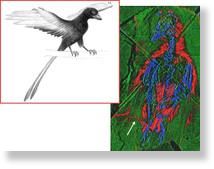
Today's birds display a panoply of colors: Robins have orange breasts, canaries are usually yellow, and blackbirds - well, despite the name, they often mix basic black with bright hues of yellow and red. Ornithologists think birds evolved these colors to attract mates, camouflage themselves from predators, and recognize fellow members of their species in the crowded sky. Very recently, scientists have been able to detect pigment-containing granules, called melanosomes, in some very early bird fossils, as well as in their immediate ancestors, the dinosaurs. And they have made educated guesses about the color of the pigments in the melanosomes based on the granules' sizes and shapes.
But melanosomes can be detected only in the best preserved fossils, which are very rare. So a team led by geochemist Roy Wogelius of the University of Manchester in the United Kingdom set about to bypass the melanosomes and look directly for traces of the pigments themselves, which often tightly bind to elements such as copper, cobalt, zinc, and calcium. Using a variety of techniques, including Synchrotron Rapid Scanning X-ray Fluorescence - a chemical imaging method developed at Stanford University that permits the detection of low levels of elements across large surfaces - the team was able to visualize the remains of pigments in several fossil birds, including the 150-million-year-old Archaeopteryx and the 125-million-year-old Confuciusornis.
Wogelius and his colleagues, whose research is reported online today in Science, were also able to detect pigments in the eyes of fossil fish and squid. Moreover, in the case of the prehistoric birds, the chemical imaging clearly revealed the outlines of the feathers, strongly suggesting that the researchers were picking up pigment traces from these plumes. To bolster their case even more, the researchers report that in some of the specimens, they were able to visualize not only the macroscopic outlines of feathers but also the microscopic shapes of melanosomes that had long ago disintegrated.
Nevertheless, it is still early days for this research: Although the researchers were able to determine, by the concentration of copper and other elements, that the feathers of fossil birds such as Confuciusornis had darker and lighter areas, they are not yet able to tell what colors these represent. Nevertheless, Wogelius says that he and his co-workers are now approaching numerous museums and other institutions in an attempt to expand their fossil database and also compare the pigment patterns of ancient specimens with those of living animals in hopes of eventually deciphering the ancient colors.
The study "promises to develop a colorful picture of ancient life," says Luis Chiappe, a paleontologist and early bird expert at the Natural History Museum of Los Angeles County in California. "The authors have presented a very solid case of how trace metals can serve as proxies for pigmentation in extinct animals." Matthew Shawkey, a biologist at the University of Akron in Ohio who has been working with dinosaur researchers to figure out the colors of those prehistoric beasts, adds that the study should help sway those skeptics who think that the melanosomes detected in some fossil specimens are really bacteria and not pigment granules.
Chiappe notes that "these techniques are thus far telling us little about how these animals used their colors," such as for courtship or camouflage. But, he says, "as we gather more and more information about their color patterns, we may be able to make some very interesting discoveries about the biology of early birds and their dinosaurian predecessors."



Reader Comments
to our Newsletter